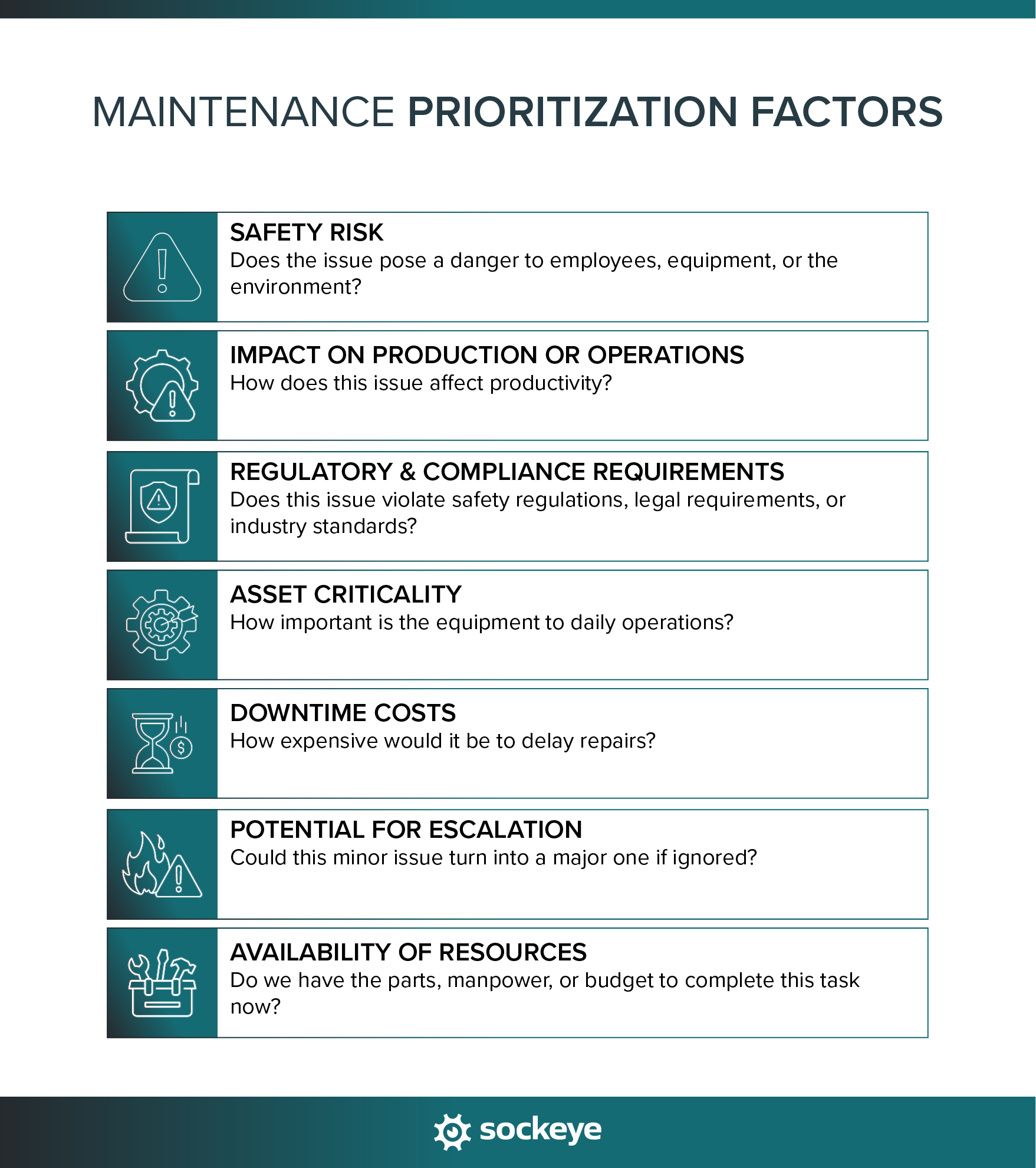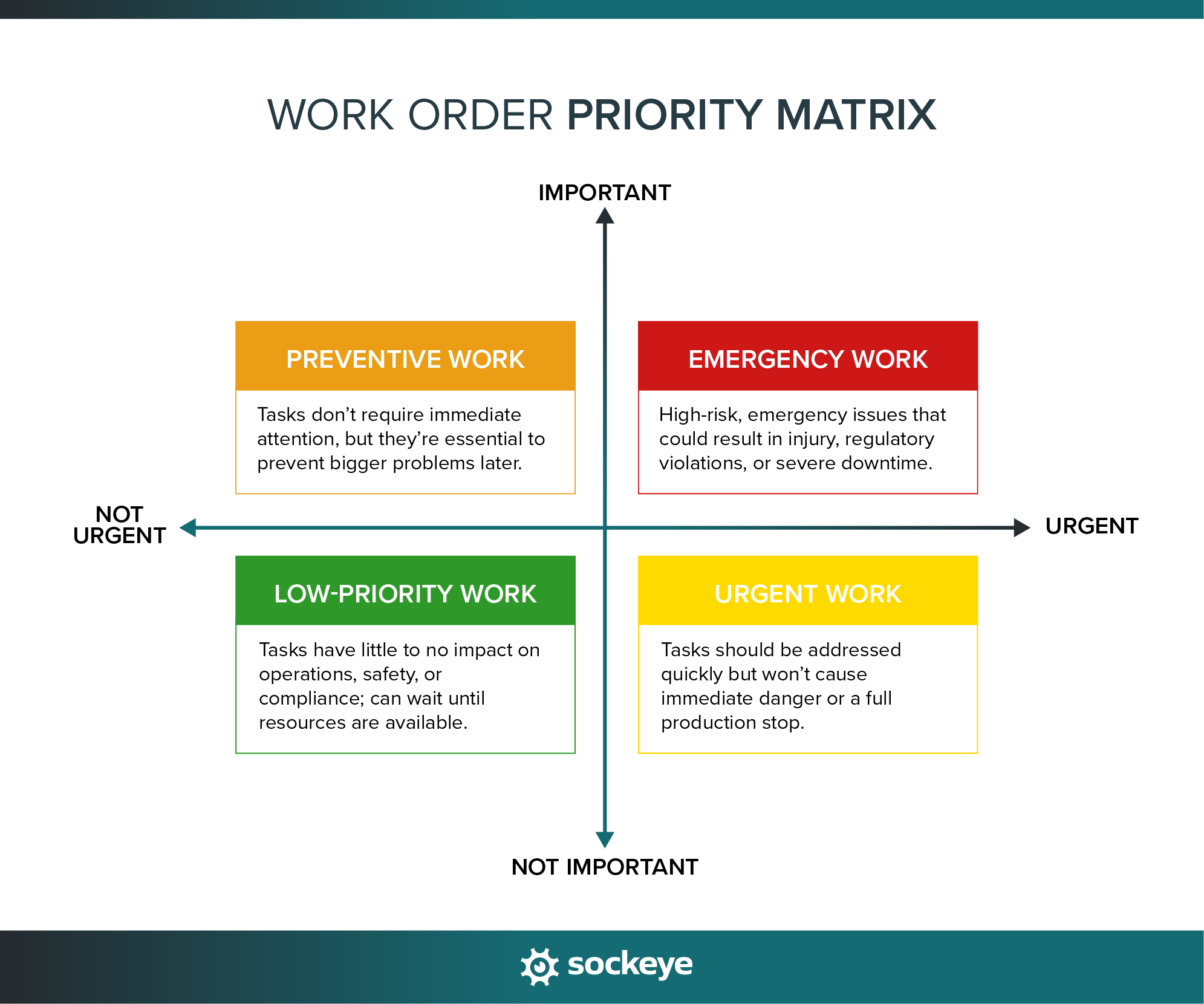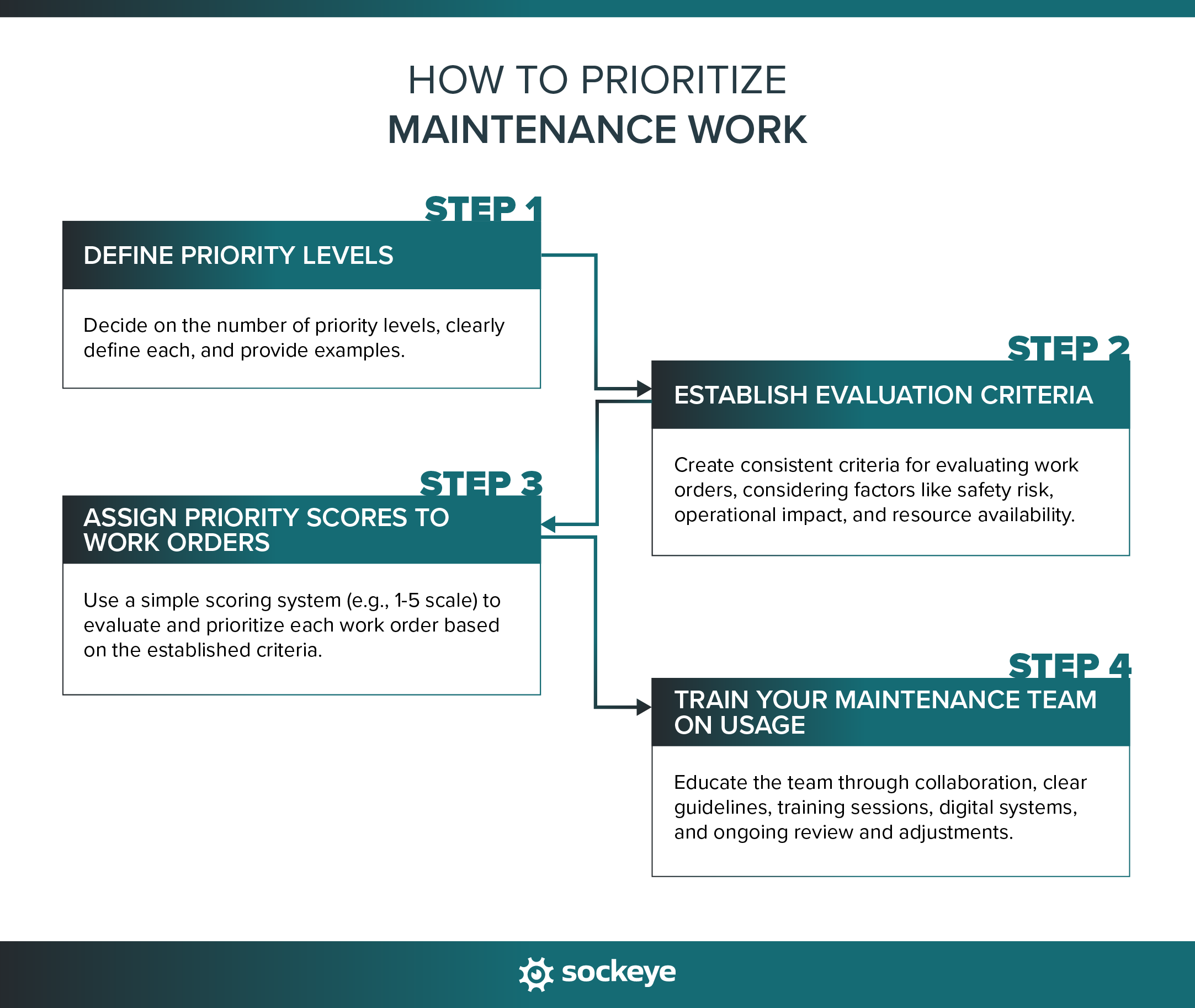Poor maintenance prioritization is a recipe for disaster. When teams don’t have a clear system for deciding which work orders should come first, everything suffers — downtime increases, safety risks pile up, and resources get wasted on the wrong tasks.
The good news? There’s a fairly simple and effective way to stay organized: a work order priority matrix. This tool helps maintenance teams quickly determine which tasks need immediate attention and which can wait, making scheduling more efficient and reducing chaos.
In this article, we’ll break down:
- The basic priority levels for work orders
- The key factors to consider when prioritizing maintenance work
- How to create and use a work order priority matrix
- Step-by-step example of how to prioritize maintenance work
- Common challenges that derail prioritization and how to avoid them
By the end, you’ll have a clearer idea of how to prioritize maintenance work orders and keep your operations running smoothly.
The basic maintenance priority levels
Not every maintenance team uses the same priority levels, and there aren’t any strict rules on how many you should have. Some teams will try to keep it simple with just the three basic levels. That said, industry best practices suggest using four levels — Low, Medium, High, and Critical — to ensure work orders are properly categorized without overcomplicating things.
The key is to set clear definitions so that everyone on the team knows what each priority level means.

Low priority work
These are tasks that don’t impact safety, production, or operations in a meaningful way. They can be scheduled for a later date without causing issues.
Examples of low-priority work:
- Painting walls or equipment for aesthetic purposes.
- Replacing one of the light bulbs in a non-essential area.
- Organizing tools in a storage room.
- Repairing minor cosmetic damage, like a dent in a machine.
Since these tasks don’t affect efficiency or safety, they’re often addressed only when there’s extra time or resources available.
Medium priority work
Medium-priority tasks should be completed within a reasonable timeframe because they could lead to bigger problems if left unaddressed. However, they aren’t emergencies.
Examples of medium-priority work:
- Replacing worn belts or hoses before they fail.
- Servicing HVAC systems to maintain optimal performance.
- Other kinds of preventive work on non-critical assets.
- Fixing a slow leak in non-critical piping.
- Addressing minor software or sensor malfunctions that don’t immediately stop operations.
These jobs might not be urgent, but delaying them too long can lead to costly breakdowns or inefficiencies.
High priority work
High-priority work needs attention as soon as possible because it poses a significant risk to operations, productivity, or safety. While not as critical as an emergency, these tasks should be addressed as soon as reasonably possible.
Examples of high-priority work:
- A key production machine running at reduced efficiency.
- A failing pump that could cause flooding if not addressed.
- A critical cooling system showing signs of overheating.
- Replacing worn-out safety guards on equipment.
- All kinds of preventive maintenance work on critical assets.
These jobs should be scheduled first — unless there is more pressing emergency work that needs to be handled.
Depending on the situation, you might need to take resources off of medium or low-priority work (which would then be rescheduled), allowing the high-priority work to be completed sooner.
Critical work
Critical work orders must be handled immediately because they present a direct safety risk, regulatory violation, or major operational failure. Any delay could result in injuries, serious legal consequences, or a complete production shutdown.
Examples of critical work:
- A gas leak or major electrical fault.
- A conveyor belt failure stopping production.
- Chiller or boiler system failure in a facility where temperature control is critical.
- Faulty brakes on a forklift or other frequently used heavy machinery, creating a safety hazard.
- Failure of a backup generator during a power outage.
Critical tasks override all other work orders and require immediate resources to be addressed ASAP.
Factors to look at when deciding work order priority levels
The above categorization sounds simple, but assigning the right priority to a work order isn’t always straightforward. To select a priority level, maintenance planners and schedulers need to weigh multiple factors at once while considering various resource constraints.

Here is a quick cheat sheet to follow:
1. Safety risk
Does the issue pose a danger to employees, equipment, or the environment?
- If a failure could result in injury or a hazardous situation (e.g., exposed wiring, gas leaks, malfunctioning safety systems), it should be Critical.
- If there’s no immediate risk, but it could develop into one (e.g., a missing handrail, deteriorating PPE storage), it might be a High or Medium priority.
2. Impact on production or operations
How does this issue affect productivity?
- If a machine failure halts production entirely, it’s Critical.
- If the issue reduces efficiency but doesn’t stop operations (e.g., a motor running at a lower speed), it’s High priority.
- If the task has no impact on daily operations (e.g., repainting an office), it’s Low priority.
3. Regulatory & compliance requirements
Does this issue violate safety regulations, legal requirements, or industry standards?
- Non-compliance with OSHA, EPA, FDA, or other regulations often makes an issue Critical because it can lead to fines, shutdowns, or legal liability.
- If a task must be completed within a timeframe for compliance but isn’t an immediate hazard, it might be a High or Medium priority.
4. Asset criticality
How important is the equipment to daily operations?
- A breakdown in a key production machine means higher priority.
- A failure in a redundant or backup system might not be as urgent.
- Non-essential equipment (e.g., a break room coffee machine) is a Low priority.
5. Downtime costs
How expensive would it be to delay repairs?
- If the issue causes unplanned downtime with high costs, it should be at least a High priority.
- If the cost impact is minimal or negligible, it’s likely Medium or Low priority.
6. Potential for escalation
Could this minor issue turn into a major one if ignored?
- A small oil leak today could lead to a catastrophic failure in a few weeks, as well as safety issues like a potential slipping hazard.
- A loose conveyor belt might not stop production now, but it could break suddenly.
- If an issue is deteriorating quickly, it should be a higher priority to prevent future breakdowns.
7. Availability of resources
Do we have the parts, labor, or budget to complete this task now?
- If the fix requires special parts or expertise that aren’t available, it might need to be scheduled rather than treated as an emergency.
- Instead, if the necessary materials and staff are ready to go, it may be easier to address a lower-priority issue sooner.
Key components of the work order priority matrix
A work order priority matrix, also known as a maintenance priority matrix, helps teams quickly determine the priority of maintenance tasks by balancing two key factors:
- Urgency: Refers to how immediate the issue is. Does it need to be fixed right now, or can it wait?
- Importance: Refers to how critical the issue is in the grand scheme of operations. How big of an issue will it cause if left unaddressed?
A task might be urgent but not very important — or important but not urgent. The priority matrix helps decide what gets done first by weighing these factors together. Instead of making subjective decisions, it provides a structured way to prioritize work orders based on real impact.

Based on this maintenance priority matrix, we have four categories:
- Critical & Urgent: These are high-risk, emergency issues that require immediate action. Any delay could result in injury, regulatory violations, or severe production downtime.
- Important but Not Urgent: These tasks don’t require immediate attention, but they’re essential to prevent bigger problems later (think preventive maintenance work). They should be scheduled proactively to avoid future emergencies.
- Urgent but Not Critical: These tasks should be addressed quickly but won’t cause immediate danger or a full production stop. They impact efficiency and operations but aren’t an emergency.
- Not important or Urgent: These tasks have little to no impact on operations, safety, or compliance. They are mostly nice-to-have or convenience-related and can wait until resources are available.
If you look at the above breakdown more closely, you will see that these four quadrants basically match the four maintenance priority levels (low – medium – high – critical) we outlined earlier in the article.
So, once importance and urgency are determined, use the following guide to assign priority levels:

Using the maintenance priority matrix
The potential problem with the work order priority matrix is that using just two factors leaves a lot of grey areas. Without clear rules and a bunch of examples, planners and schedulers might have a hard time distinguishing between medium and high-priority work.
One way to alleviate that problem is to assign scores (1-5 for example) to both factors. Then correlate the score with a priority level.

We have two examples below.
Scenario 1: Hydraulic leak on a production line machine
- Importance – High (4/5) → This machine is essential to production, and a failure could disrupt operations.
- Urgency – High (5/5) → The leak is worsening and could cause a breakdown if not fixed immediately.
- Total score = 9/10 → Critical Priority (Fix now!)
Scenario 2: Worn bearings on a secondary conveyor system
- Importance – Medium (3/5) → The conveyor is not the main production line but is still important for material movement. If it fails, workarounds are possible, but efficiency will drop.
- Urgency – Medium (3/5) → The bearings are making noise, indicating wear, but the conveyor is still operational. If left too long, failure is likely, leading to unplanned downtime.
- Total score = 6/10 → Medium Priority (schedule within a reasonable timeframe)
How to prioritize maintenance work
Prioritizing maintenance work effectively requires a clear process that every team member understands and follows.

Step 1: Define priority levels
This is the easy part. Decide how many priority levels you will use and what each level means. Include several examples for each maintenance priority level.
For the vast majority of maintenance teams out there, having 3 to 5 levels should suffice. If you don’t want to start from scratch, you can always refer to the breakdown we give in this article.
Step 2: Establish evaluation criteria
To ensure consistency, every work order should be evaluated using the same set of criteria.
You can take two approaches here. The simpler one is to only look at the two key criteria from the work order priority matrix: Importance and Urgency.
The more nuanced approach would be to look at all of the factors we discussed earlier in the article:
- Safety risk: Does this issue pose an immediate danger?
- Operational impact: Will this stop production or reduce efficiency?
- Regulatory compliance: Does this put the company at risk of fines or legal issues?
- Escalation potential: Will this get worse if ignored?
- Downtime cost: How much money will be lost if this isn’t fixed quickly?
- Resource availability: Do we have the labor and parts to fix it now?
Note that these factors are not set in stone. Your organization might value different things. For example, if you are not in a highly regulated industry, you might want to exclude “regulatory compliance” from the analysis so it doesn’t skew your final scores.
Step 3: Assign priority scores to work orders
Once you have criteria in place, you can assign a priority score to each work order. Again, a simple scoring system (1-5 scale for each factor) should suffice.

Here are a couple of examples of maintenance prioritization using this table.
Scenario 1: Loose drive belt on a packaging machine
- Safety risk – Low (2/5) → No immediate danger to operators, but a sudden belt failure could cause unexpected hazards.
- Operational impact – Medium (3/5) → The machine is still running, but with reduced efficiency. If the belt slips further, it could cause misalignment and packaging errors.
- Regulatory compliance – Low (2/5) → No immediate compliance issues, but inconsistent packaging may affect product quality.
- Escalation potential – Medium (3/5) → If not addressed soon, the belt could snap, leading to unexpected downtime and increased repair costs.
- Downtime cost – Medium (3/5) → If the machine goes down unexpectedly, it could delay shipments but won’t shut down the entire production line.
- Total Score = 13/25 → Medium Priority
Scenario 2: HVAC filter replacement in an office area
- Safety risk – Low (1/5)
- Operational impact – Low (2/5)
- Regulatory compliance – Low (2/5)
- Escalation potential – Medium (3/5)
- Downtime cost – Low (1/5)
- Total score = 9/25 → Low Priority
As you can see, there is no way to completely eliminate subjectivity from the prioritization process. Even using this approach, schedulers will have to rely on their experience to some degree when assigning a score to each factor.
This is not necessarily a bad thing as you will need some flexibility in the scheduling process to account for other factors that might not be covered here.
Step 4: Train your maintenance team on usage
Whichever approach you take, your team needs to know what to do and be willing to follow it. Here’s how to ensure adoption:
- Encourage collaboration: To give people the feeling of ownership, consider involving the whole team when setting priority levels and prioritization factors.
- Provide clear guidelines: Document priority levels and evaluation criteria. Preferably in the form of a Standard Operating Procedure (SOP). Make sure the document is easily accessible through your CMMS or other digital system.
- Hold training sessions: Walk teams through real-world scenarios and practice prioritizing work orders. Focus on common mistakes and edge cases.
- Use a digital system: If using a CMMS, you can usually configure priority levels in one click, selecting it from a drop-down menu during WO creation. This is going to make life easier for schedulers who can then use a dedicated maintenance scheduling add-on like Sockeye to schedule work based both on priority and technician availability (which is provided by Sockeye).
- Review and adjust: Track how well the system works and tweak it as needed for better efficiency.
Even the best systems can face roadblocks. In the next section, we’ll discuss the most common prioritization challenges — and how to avoid them.
Things that can derail maintenance prioritization
Here are some general challenges that can make the maintenance prioritization process much harder than it needs to be — and tips for fixing them.
- Lack of clear criteria for prioritization. Standardize priority definitions and scoring criteria so that everyone follows the same rules when assigning priority levels.
- Too many “Urgent” requests. When everything is labeled as urgent, nothing is truly urgent. Set strict guidelines for what qualifies as a “Critical” or “High” priority work order. Require justification before escalating requests.
- Poor communication with production, operations, or safety team. Leads to important issues being missed, delayed, or misprioritized. Improve cross-department communication with regular meetings and shared dashboards.
- Incomplete or incorrect work order information: Make sure your planners and schedulers have all of the data they need by standardizing your work order request process and your work order forms.
- Too much reactive work. You will need to allocate time and resources to schedule more PMs and create a deferred maintenance plan (if needed). This is easier said than done. Consider investing in tools like Sockeye — it will help you be more efficient and schedule more work by optimizing labor hours.
Even when priorities are clear, work can be delayed due to staff shortages, unavailable parts, or budget restrictions. Addressing each of those could be a standalone article. As a bandaid, you can always look into different maintenance solutions — they can help you get the most out of your existing resources.
Simplify work order scheduling and prioritization with Sockeye
Large teams managing multiple assets should not rely on outdated tools like Excel or cumbersome CMMS functionality to schedule work and manage work orders.
We understand that some CMMS solutions, while being great for other things like parts inventory and work request management, have a very rigid or complicated scheduling function. But going back to spreadsheets is not the right move.
There is a better way, and it is called Sockeye. It is a CMMS bolt-on that is exclusively focused on simplifying maintenance scheduling and reporting. It has a two-way integration with any CMMS solution, so you do not lose any data along the way.
Here is more info on how it works:
Using a tool like Sockeye will help your team stay proactive, ensure consistency in work order prioritization, and become more productive.
Book a quick call with our team to see how easy it would be to implement Sockeye at your facility.